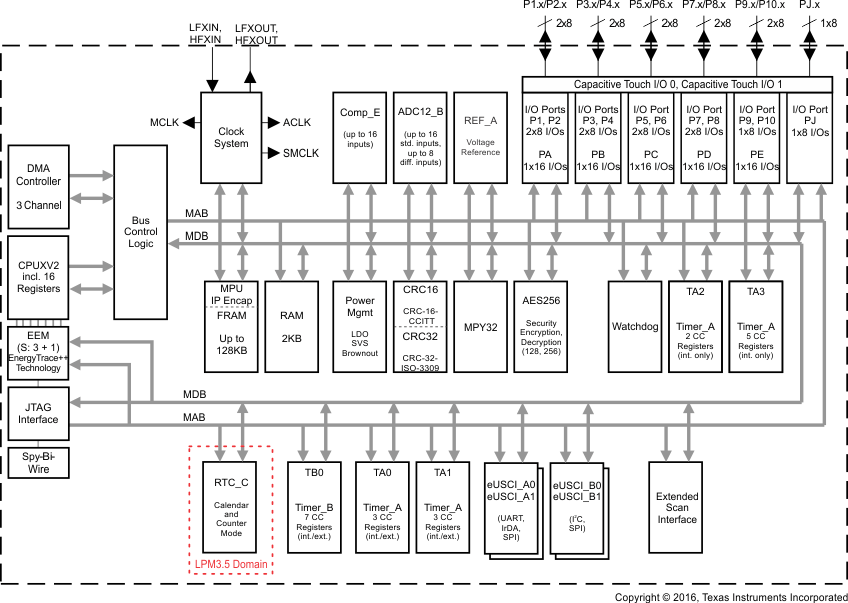JAJSD97 April 2017 MSP430FR5989-EP
PRODUCTION DATA.
- 1デバイスの概要
- 2改訂履歴
- 3Terminal Configuration and Functions
-
4 Specifications
- 4.1 Absolute Maximum Ratings
- 4.2 ESD Ratings
- 4.3 Recommended Operating Conditions
- 4.4 Active Mode Supply Current Into VCC Excluding External Current
- 4.5 Typical Characteristics, Active Mode Supply Currents
- 4.6 Low-Power Mode (LPM0, LPM1) Supply Currents Into VCC Excluding External Current
- 4.7 Low-Power Mode (LPM2, LPM3, LPM4) Supply Currents (Into VCC) Excluding External Current
- 4.8 Low-Power Mode With LCD Supply Currents (Into VCC) Excluding External Current
- 4.9 Low-Power Mode LPMx.5 Supply Currents (Into VCC) Excluding External Current
- 4.10 Typical Characteristics, Low-Power Mode Supply Currents
- 4.11 Typical Characteristics, Current Consumption per Module
- 4.12 Thermal Resistance Characteristics
- 4.13
Timing and Switching Characteristics
- 4.13.1 Power Supply Sequencing
- 4.13.2 Reset Timing
- 4.13.3 Clock Specifications
- 4.13.4 Wake-up Characteristics
- 4.13.5 Peripherals
- 4.13.6 Emulation and Debug
-
5Detailed Description
- 5.1 Overview
- 5.2 CPU
- 5.3 Operating Modes
- 5.4 Interrupt Vector Table and Signatures
- 5.5 Bootloader (BSL)
- 5.6 JTAG Operation
- 5.7 FRAM
- 5.8 RAM
- 5.9 Tiny RAM
- 5.10 Memory Protection Unit Including IP Encapsulation
- 5.11
Peripherals
- 5.11.1 Digital I/O
- 5.11.2 Oscillator and Clock System (CS)
- 5.11.3 Power-Management Module (PMM)
- 5.11.4 Hardware Multiplier (MPY)
- 5.11.5 Real-Time Clock (RTC_C)
- 5.11.6 Watchdog Timer (WDT_A)
- 5.11.7 System Module (SYS)
- 5.11.8 DMA Controller
- 5.11.9 Enhanced Universal Serial Communication Interface (eUSCI)
- 5.11.10 Extended Scan Interface (ESI)
- 5.11.11 Timer_A TA0, Timer_A TA1
- 5.11.12 Timer_A TA2
- 5.11.13 Timer_A TA3
- 5.11.14 Timer_B TB0
- 5.11.15 ADC12_B
- 5.11.16 Comparator_E
- 5.11.17 CRC16
- 5.11.18 CRC32
- 5.11.19 AES256 Accelerator
- 5.11.20 True Random Seed
- 5.11.21 Shared Reference (REF_A)
- 5.11.22 LCD_C
- 5.11.23 Embedded Emulation
- 5.11.24
Input/Output Diagrams
- 5.11.24.1 Digital I/O Functionality - Ports P1 to P10
- 5.11.24.2 Capacitive Touch Functionality Ports P1 to P10 and PJ
- 5.11.24.3 Port P1 (P1.0 to P1.3) Input/Output With Schmitt Trigger
- 5.11.24.4 Port P1 (P1.4 to P1.7) Input/Output With Schmitt Trigger
- 5.11.24.5 Port P2 (P2.0 to P2.3) Input/Output With Schmitt Trigger
- 5.11.24.6 Port P2 (P2.4 to P2.7) Input/Output With Schmitt Trigger
- 5.11.24.7 Port P3 (P3.0 to P3.7) Input/Output With Schmitt Trigger
- 5.11.24.8 Port P4 (P4.0 to P4.7) Input/Output With Schmitt Trigger
- 5.11.24.9 Port P5 (P5.0 to P5.7) Input/Output With Schmitt Trigger
- 5.11.24.10 Port P6 (P6.0 to P6.6) Input/Output With Schmitt Trigger
- 5.11.24.11 Port P6 (P6.7) Input/Output With Schmitt Trigger
- 5.11.24.12 Port P7 (P7.0 to P7.7) Input/Output With Schmitt Trigger
- 5.11.24.13 Port P8 (P8.0 to P8.3) Input/Output With Schmitt Trigger
- 5.11.24.14 Port P8 (P8.4 to P8.7) Input/Output With Schmitt Trigger
- 5.11.24.15 Port P9 (P9.0 to P9.3) Input/Output With Schmitt Trigger
- 5.11.24.16 Port P9 (P9.4 to P9.7) Input/Output With Schmitt Trigger
- 5.11.24.17 Port P10 (P10.0 to P10.2) Input/Output With Schmitt Trigger
- 5.11.24.18 Port PJ (PJ.4 and PJ.5) Input/Output With Schmitt Trigger
- 5.11.24.19 Port PJ (PJ.6 and PJ.7) Input/Output With Schmitt Trigger
- 5.11.24.20 Port PJ (PJ.0 to PJ.3) JTAG Pins TDO, TMS, TCK, TDI/TCLK, Input/Output With Schmitt Trigger
- 5.12 Device Descriptors (TLV)
- 5.13 Memory
- 5.14 Identification
- 6Applications, Implementation, and Layout
- 7デバイスおよびドキュメントのサポート
- 8メカニカル、パッケージ、および注文情報
1 デバイスの概要
1.1 特長
- 組み込みマイクロプロセッサ
- 16ビットのRISCアーキテクチャ、最高クロック16MHz
- 広い電源電圧範囲(1.8V~3.6V)
- SVSH電源オン・レベルに従い、最低1.99Vの電源電圧が電源オンのため必要
- 最適化された超低消費電力モード
- アクティブ・モード: 約100µA/MHz
- スタンバイ(VLOありのLPM3): 0.4µA (標準値)
- リアルタイム・クロック(RTC) (LPM3.5): 0.35µA (標準値) (1)
- シャットダウン(LPM4.5): 0.02µA (標準値)
- 超低消費電力の強誘電体RAM (FRAM)
- 最大128KBの不揮発性メモリ
- 超低消費電力の書き込み
- ワードあたり125nsの高速書き込み(4msで64KB)
- ユニファイド・メモリによりプログラム、データ、ストレージを1か所に保存
- 1015書き込みサイクルの耐久性
- 放射耐性および非磁性
- インテリジェントなデジタル・ペリフェラル
- 32ビットのハードウェア・マルチプライヤ(MPY)
- 3チャネルの内蔵ダイレクト・メモリ・アクセス(DMA)
- カレンダーおよびアラーム機能を持つRTC
- 5つの16ビット・タイマ、それぞれに最大7つのキャプチャ/比較レジスタを搭載
- 16ビットおよび32ビットの巡回冗長性検査(CRC16、CRC32)
- 高性能アナログ
- 16チャネルのアナログ・コンパレータ
- 12ビットのアナログ/デジタル・コンバータ(ADC)、基準電圧とサンプル・アンド・ホールド機能を内蔵し、最大16の外部入力チャネル
- 最大320セグメントのコントラスト制御を搭載した内蔵LCDドライバ
- マルチファンクションの入力/出力ポート
- P1~P10およびPJピンはすべて、外付け部品の必要なしに容量性タッチ能力をサポート
- ビット、バイト、ワード単位でアクセス可能(ペアで)
- ポートP1、P2、P3、P4上でLPMからウェークアップをエッジ選択可能
- すべてのポートでプルアップおよびプルダウンをプログラム可能
- コードのセキュリティ
- 真の乱数シードによる乱数生成アルゴリズム
- シリアル通信の拡張機能
- eUSCI_A0およびeUSCI_A1でのサポート
- 自動ボーレート検出機能付きのUART
- IrDAのエンコードおよびデコード
- SPI
- eUSCI_B0およびeUSCI_B1でのサポート
- 複数のスレーブ・アドレッシングを持つI2C
- SPI
- ハードウェアUARTまたはI2Cブートローダー(BSL)
- eUSCI_A0およびeUSCI_A1でのサポート
- 柔軟なクロック・システム
- 固定周波数DCO、出荷時にトリムされた10の周波数を選択可能
- 低電力、低周波数の内部クロック・ソース(VLO)
- 32kHzの水晶振動子(LFXT)
- 高周波数の水晶振動子(HFXT)
- 開発ツールとソフトウェア
- 無償のプロフェッショナル開発環境 : EnergyTrace++™ テクノロジを使用
- 実験および開発キット
- 管理されたベースライン
- 単一のアセンブリ/テスト施設、単一の製造施設
- 強化された DMS(Enhanced Diminishing Manufacturing Sources)サポート
- 早期製品変更通知(PCN)
- 認定系譜
1. RTCは3.7pFの水晶振動子によりクロック供給を受けます。
1.2 アプリケーション
- 水量メータ
- 熱メータ
- ヒート・コスト・アロケータ
- ポータブル医療用メーター
- データ・ロギング
1.3 概要
MSP430™超低消費電力(ULP) FRAMプラットフォームは、独自の組み込みFRAMと包括的な超低消費電力システム・アーキテクチャとを組み合わせ、より低いエネルギー・バジェットで性能向上を可能にした、イノベータ向けの製品です。FRAMテクノロジにより、SRAMの速度、柔軟性、耐久性と、フラッシュの安定性および信頼性の両方が、はるかに低い消費電力で得られます。
MSP430 ULP FRAMポートフォリオは、FRAM、ULP 16ビットMSP430 CPU、およびインテリジェントなペリフェラルを搭載し、各種のアプリケーションを対象とした、多様なデバイスのセットで構成されます。ULPアーキテクチャには7つの低消費電力モードがあり、エネルギーの制約が厳しいアプリケーションでバッテリ駆動時間を延長できるよう最適化されています。
このデバイスは高信頼性の拡張製品として、制御されたベースライン、拡張温度範囲(-55℃~95℃)、パッケージ内の金結合ワイヤを持ち、ミッション・クリティカルなアプリケーションに特に適しています。
